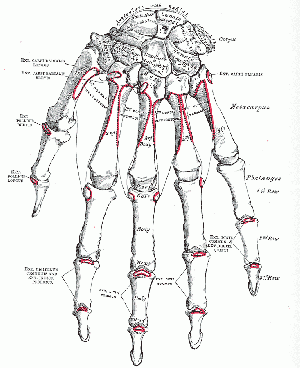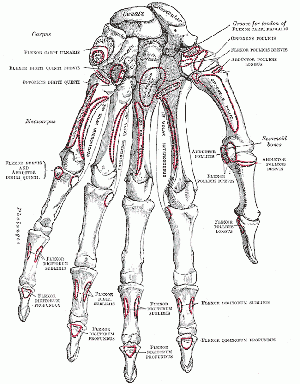Wrist and Hand: Difference between revisions
Kim Jackson (talk | contribs) No edit summary |
Kim Jackson (talk | contribs) No edit summary |
||
| Line 17: | Line 17: | ||
'''The carpus''' consists of eight bones, sitting in two rows, with four bones in each row (figure 1). The carpus controls length-tension relationships in the multiarticular hand muscles and to allow fine adjustment of grip.<ref>Levangie PK, Norkin CC. Joint Structure and Function: A Comprehensive Analysis. 5th Ed. Philadelphia: F A Davis Company, 2011</ref> | '''The carpus''' consists of eight bones, sitting in two rows, with four bones in each row (figure 1). The carpus controls length-tension relationships in the multiarticular hand muscles and to allow fine adjustment of grip.<ref>Levangie PK, Norkin CC. Joint Structure and Function: A Comprehensive Analysis. 5th Ed. Philadelphia: F A Davis Company, 2011</ref> | ||
Three of the bones in the proximal row articulate with the radius forming the radiocarpal joint and distally with the distal carpal forming the midcarpal joint. The four carpal bones in the distal row articulate with the bases of the five metacarpal bones forming the carpometacarpal joints<ref>Principles of Anatomy & Physiology. Tortora GJ, Derrickson B. 13th Ed. NJ: John Wiley & Sons, Inc, 2012.</ref>. The joints formed between the carpal bones are known as the intercarpal joints and most are of the plane synovial type<ref name=":0" />, as the bones interlock with each other the rows are sometimes referred to as two single synovial joints<ref name=":0" />. | Three of the bones in the proximal row articulate with the radius forming the radiocarpal joint and distally with the distal carpal forming the midcarpal joint. The four carpal bones in the distal row articulate with the bases of the five metacarpal bones forming the carpometacarpal joints<ref name=":1">Principles of Anatomy & Physiology. Tortora GJ, Derrickson B. 13th Ed. NJ: John Wiley & Sons, Inc, 2012.</ref>. The joints formed between the carpal bones are known as the intercarpal joints and most are of the plane synovial type<ref name=":0" />, as the bones interlock with each other the rows are sometimes referred to as two single synovial joints<ref name=":0" />. | ||
{| width="40%" cellspacing="1" cellpadding="1" border="0" align="right" class="FCK__ShowTableBorders" | {| width="40%" cellspacing="1" cellpadding="1" border="0" align="right" class="FCK__ShowTableBorders" | ||
|+Figure 1 - Bones of the Hands | |+Figure 1 - Bones of the Hands | ||
| Line 26: | Line 26: | ||
The arrangement of the bones and ligaments allows very little movement between bones<ref name=":0" />, but they do slide contributing to the finer movements of the wrist (Functional anatomy: musculoskeletal anatomy. Kinesiology and palpation for manual therapists). The exception to this is the capitate which has a larger range of movement<ref name=":0" />. The small bones are named after the shape they resemble. | The arrangement of the bones and ligaments allows very little movement between bones<ref name=":0" />, but they do slide contributing to the finer movements of the wrist (Functional anatomy: musculoskeletal anatomy. Kinesiology and palpation for manual therapists). The exception to this is the capitate which has a larger range of movement<ref name=":0" />. The small bones are named after the shape they resemble. | ||
==== Proximal Row<ref name=":1" /> ==== | |||
* '''Scaphoid''' – (boat like)– anterior surface palpable tubercle. Articulates proximally with radius, medially with lunate and distally with the head of the capitate. It is a common site of fracture- 70% of all carpal fractures<ref name=":1" />, often injured by a fall onto an outstretched limb | |||
* '''Lunate''' – (moon shaped) – Its palmar surface is smooth and convex and is larger than its dorsal surface. Proximally it articulates with the radius and articular disc, medially with the triquetrum, laterally with the scaphoid and distally with the head of the capitate | |||
* '''Triquetrum''' – (three cornered) – Nestles in the space between the lunate and hamate. When the hand is adducted it enters the radiocarpal joint. | |||
* '''Pisiform''' – (pea shaped) = a small round bone found in the tendon of flexor carpi ulnaris. It articulates with the palmar surface of the triquetrum. The anterior surface projects distally and laterally forming the medial part of the carpal tunnel. | |||
{| width="40%" cellspacing="1" cellpadding="1" border="0" align="right" class="FCK__ShowTableBorders" | {| width="40%" cellspacing="1" cellpadding="1" border="0" align="right" class="FCK__ShowTableBorders" | ||
|- | |- | ||
Revision as of 18:09, 22 July 2018
Original Editors - Rachael Lowe
Top Contributors - Kim Jackson, Rachael Lowe, Lucinda hampton, Laura Ritchie, George Prudden, Wendy Snyders, Joao Costa, Mande Jooste, Admin, Cheryl Rentchler, Nikhil Benhur Abburi, Abdallah Ahmed Mohamed, Tony Lowe and Evan Thomas
Introduction[edit | edit source]
The upper limb has sacrificed locomotor function and stability for mobility, dexterity and precision. The hand sits at the end of the upper limb and is a combination of complex joints whose function is to manipulate, grip and grasp- this is made possible by the opposing movement of the thumb.[1]
Anatomy[edit | edit source]
The hand and wrist have a total of 27 bones arranged to roll, spin and slide[2]; allowing the hand to explore and control the environment and objects. The hand is divided into three regions[3]:
- Proximal region of the hand is the carpus (wrist)
- The middle region the metacarpus (palm)
- The distal region the phalanges (fingers).
Bones[edit | edit source]
The carpus consists of eight bones, sitting in two rows, with four bones in each row (figure 1). The carpus controls length-tension relationships in the multiarticular hand muscles and to allow fine adjustment of grip.[4]
Three of the bones in the proximal row articulate with the radius forming the radiocarpal joint and distally with the distal carpal forming the midcarpal joint. The four carpal bones in the distal row articulate with the bases of the five metacarpal bones forming the carpometacarpal joints[5]. The joints formed between the carpal bones are known as the intercarpal joints and most are of the plane synovial type[1], as the bones interlock with each other the rows are sometimes referred to as two single synovial joints[1].
The arrangement of the bones and ligaments allows very little movement between bones[1], but they do slide contributing to the finer movements of the wrist (Functional anatomy: musculoskeletal anatomy. Kinesiology and palpation for manual therapists). The exception to this is the capitate which has a larger range of movement[1]. The small bones are named after the shape they resemble.
Proximal Row[5][edit | edit source]
- Scaphoid – (boat like)– anterior surface palpable tubercle. Articulates proximally with radius, medially with lunate and distally with the head of the capitate. It is a common site of fracture- 70% of all carpal fractures[5], often injured by a fall onto an outstretched limb
- Lunate – (moon shaped) – Its palmar surface is smooth and convex and is larger than its dorsal surface. Proximally it articulates with the radius and articular disc, medially with the triquetrum, laterally with the scaphoid and distally with the head of the capitate
- Triquetrum – (three cornered) – Nestles in the space between the lunate and hamate. When the hand is adducted it enters the radiocarpal joint.
- Pisiform – (pea shaped) = a small round bone found in the tendon of flexor carpi ulnaris. It articulates with the palmar surface of the triquetrum. The anterior surface projects distally and laterally forming the medial part of the carpal tunnel.
Clinical Examination[edit | edit source]
- Wrist & Hand Examination
- Special Tests
- Outcome Measures
Conditions[edit | edit source]
- Carpel Tunnel Syndrome
- De Quervains
- Wrist Sprain
- Carpel Instability
- Colles Fracture
- Smiths Fracture
- Scaphoid Fracture
- Wrist & Hand Osteoarthritis
- Rheumatoid Arthritis
- Complex Regional Pain Syndrome
- Triangular Fibrocartilage Complex Injuries
- Gamekeeper’s Thumb
- Blackberry Thumb
- Lunate Instability
- Hamate Fracture
- Ape Hand
- Benediction Hand
- Claw Hand
- Dupuytren’s Contracture
- Metacarpal Fractures
- Extensor Mechanism Injuries
- Flexor Tendon Injuries
- Ulnocarpal Impaction Syndrome
- Lunotriquetral Ligament Tears
Procedures[edit | edit source]
References[edit | edit source]
- ↑ 1.0 1.1 1.2 1.3 1.4 Palastanga N, Soames R. Anatomy and Human Movement: Structure and Function. 6th Ed. London: Churchill Livingstone, 2012.
- ↑ Maitland, G.D. Maitland's Peripheral Manipulations. 3rd Edition Edinburg: Elsevier Butterworth-Heinemann, 1999.
- ↑ Physical Examination of the Spine and Extremities. Hoppenfield, S. New York: Appleton-Century-Crofts, 1976.
- ↑ Levangie PK, Norkin CC. Joint Structure and Function: A Comprehensive Analysis. 5th Ed. Philadelphia: F A Davis Company, 2011
- ↑ 5.0 5.1 5.2 Principles of Anatomy & Physiology. Tortora GJ, Derrickson B. 13th Ed. NJ: John Wiley & Sons, Inc, 2012.








